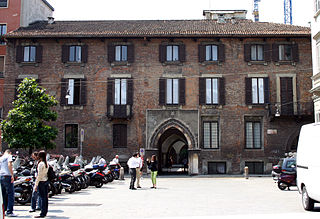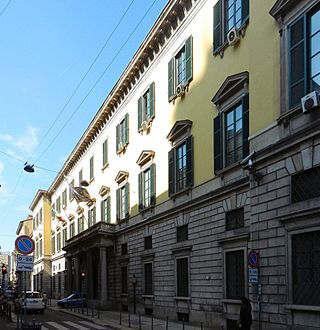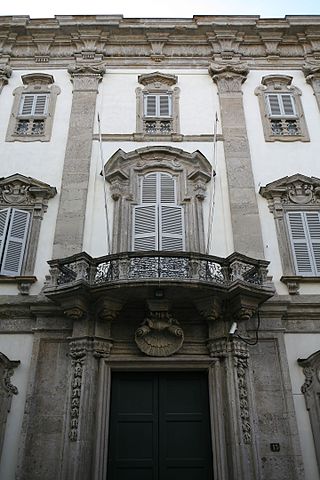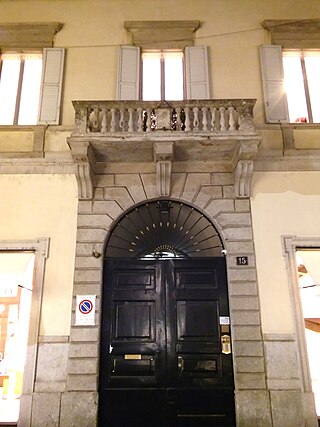History and description
Commissioned in 1580 by the Genoese banker Leonardo Spinola, [2] a trusted man of Tommaso Marino another Genoese banker, the palace was built in three separate campaigns between 1570 and 1615 by an unknown architect. Hypotheses have been put forward regarding Pellegrino Pellegrini and Martino Bassi, but only Bassi's participation would now seem undoubted; today, the building owes much of its interior appearance to 19th-century alterations: [3] the simple façade, in which the ashlar-work portal stands out, allows little to be seen of the luxurious interiors.
Famous is the Sala d'oro designed by Gerolamo Arganini and decorated by Giacomo Tazzini: the hall, remodelled on the occasion of the wedding of Emperor Ferdinand I, is spacious and monumental, surrounded by a colonnade decorated with fregi and surmounted by the entablature forming the tribune for the orchestra; [1] the frescos and gilded stuccoes on an ivory background also stand out; similarly the Sala d'silver named after the silver-coloured stuccoes by Luigi Tatti.
Badly hit by Anglo-American bombing in 1943, the building caught fire and although the architecture of the façade and courtyard remained intact, the fire destroyed almost all of the upper floors and parts of the ground floor, resulting in the collapse of the roofs and most of the vaults and the loss of the two rooms described above, of which only the walls were saved. [3]
Another noteworthy room is undoubtedly the Ballroom, whose name suggests it was the venue for balls: a room that caught the attention of Stendhal, who was a guest in the palace many times during balls and celebrations. In the garden courtyard, there is the sixteenth-century belvedere tower, a room often used in garden parties on summer occasions. [4]
Palazzo Spinola housed until his death the large studio of the painter Luigi Conconi (1852—1917), who shared it for a long time with Gaetano Previati (1852—1920). [5]

Villas and palaces in Milan are used to indicate public and private buildings in Milan of particular artistic and architectural value. Milan has always been an important centre with regard to the construction of historical villas and palaces, ranging from the Romanesque to the neo-Gothic, from Baroque to Rococo.

The Ca' de Sass is a monumental 19th century building in Milan, Italy, located close to the city centre, at numbers 6 and 8 of Via Monte di Pietà. It used to be the headquarters of Cariplo, a former Italian bank, now merged into Intesa Sanpaolo.

The Palace of the Banca Commerciale Italiana is a historic building of Milan, Italy, located in Piazza della Scala, in the city centre. It was designed by architect Luca Beltrami in the early 20th century for Banca Commerciale Italiana, and it is still in use as a seat of the company. Since 2011 it hosts the Gallerie di Piazza Scala where are exposed many artworks from the collections of Fondazione Cariplo.

Palazzo Borromeo is a 13th-century building located at street #12 of Piazza Borromeo in Milan, region of Lombardy, Italy,. It stands across a small piazza from the church of Santa Maria Podone and a statue dedicated to the 16th-century archbishop and cardinal, St Charles Borromeo.

Casa Campanini is an art nouveau building in Milan, Italy, located at 11, Via Bellini. It was completed between 1903 and 1906 by architect Alfredo Campanini, who later inhabited the building.

Castello Cova, also known as Palazzo Viviani Cova is a landmark Neo-Gothic style residential and business building located on Via Giosuè Carducci #36, in central Milan, region of Lombardy, Italy. It is located some 100 meters west of the Basilica of Sant'Ambrogio. The building was designed by architect Adolfo Coppedè. Adolfo's career is also noted for designing the Casa del Fascio in Signa, and he was never shy to indulge in the appropriation of former styles and symbols; this building notable for its height and accumulation of Gothic architecture motifs such as a merlionated tower, peaked and rusticated ground-floor arches, and mullion-windows. It sports numerous decorated balconies on the facade.

The Palazzo Brentani is a monumental Neoclassical palace, located on Via Manzoni #6, in the centre of Milan, region of Lombardy, Italy. Both this palace and the adjacent Palazzo Anguissola have sober academic facades, designed by Luigi Canonica in 1829.

Giuseppe Zanoia (1752–1817) was an Italian Neoclassical architect who is remembered for his Porta Nuova in Milan. He also collaborated on the Neogothic design of Milan's Duomo.

The Palazzo Belgioioso is a palatial residence in the northern Italian city of Milan, completed in 1781 in a Neoclassical style by Giuseppe Piermarini.

The Palazzo Anguissola or Anguissola Traversi is a palace located at Via Manzoni number 10, in central Milan, a city in the northern Italy. Construction began in 1778, and its Neoclassical facade, designed by Luigi Canonica, was added in 1829.

Casa Manzoni is a historical palace sited in via Morone 1 near the quadrilateral of fashion in the center of Milan, Italy. Owned by the Manzoni family, the house was the birthplace of the famous Italian writer Alessandro Manzoni in 1785.

Palazzo Arese was a 16th century baroque palace and seat of a branch of the House of Arese in Milan, Italy. It was located adjacent to Casa Fontana Silvestri near the Porta Orientale. The palazzo was demolished in 1943 following damage sustained during the bombing of Milan in World War II.

The Prefecture, Milan, also known as Palazzo Diotti, is a historic neoclassical building which has been the location of the office of the Prefect of Milan since 1859. The building is situated at 31, Corso Monforte in the city.

The Palazzo del Monte di Pietà, is a palazzo quattrocentesco in Milano, adapted in forme neoclassiche in the 18th century by Giuseppe Piermarini. Historically belonging to the Sestiere di Porta Nuova, it is located in Via Monte di Pietà no. 5, and was the seat of the Monte di Pietà di Milano.

The Palazzo di Prospero Visconti' is a 16th-century palace in Milan. Historically belonging to the sestiere di Porta Ticinese, it is located in via Lanzone 2, in the ancient contrada del Torchio no. 2,919.

Palazzo Isimbardi, also palazzo della Provincia, is a historic building in Milan located at 35 Corso Monforte, the seat of the Metropolitan City of Milan.

Palazzo Visconti di Grazzano, also known as Palazzo Visconti di Modrone or Palazzo Bolagnos, is a historical palace located in the centre of Milan, in Via Cino del Duca no. 8.

Palazzo Cusani is a 17th-century palace in Milano, remodelled a first time between 1712 and 1719 and a second time between 1775 and 1779. Historically belonging to the sestiere of Porta Nuova, it is located at via Brera 13–15.

Casa Crespi is a historic building in Milan located at 15 Via Sant’Andrea.






















